Page 1323 of 1865
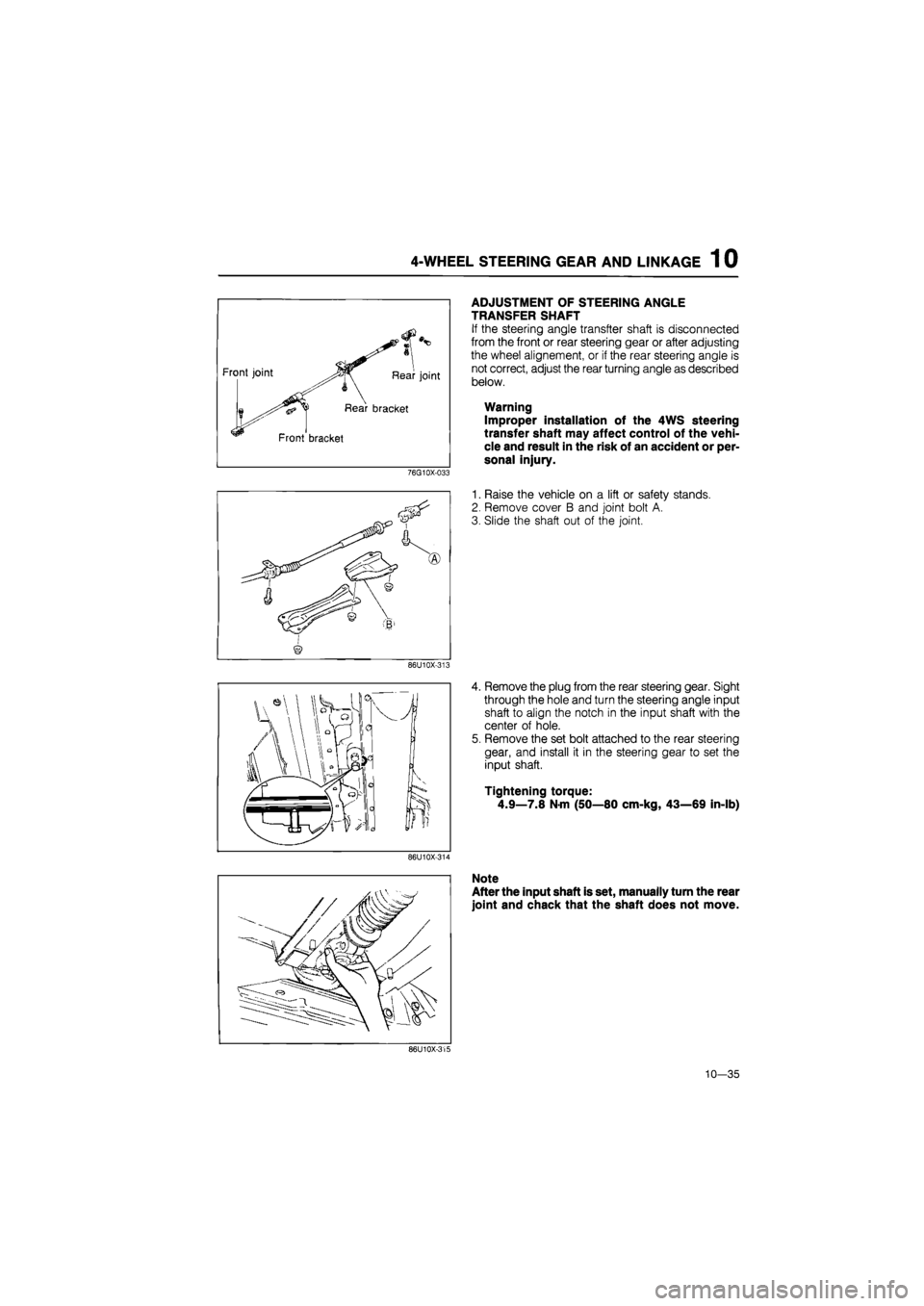
4-WHEEL STEERING GEAR AND LINKAGE 1 0
Front joint Rear joint
Rear bracket
Front bracket
76G10X-033
86U10X-313
ADJUSTMENT OF STEERING ANGLE
TRANSFER SHAFT
If the steering angle transfter shaft is disconnected
from the front or rear steering gear or after adjusting
the wheel alignement, or if the rear steering angle is
not correct, adjust the rear turning angle as described
below.
Warning
Improper installation of the 4WS steering
transfer shaft may affect control of the vehi-
cle and result in the risk of an accident or per-
sonal injury.
1. Raise the vehicle on a lift or safety stands.
2. Remove cover B and joint bolt A.
3. Slide the shaft out of the joint.
4. Remove the plug from the rear steering gear. Sight
through the hole and turn the steering angle input
shaft to align the notch in the input shaft with the
center of hole.
5. Remove the set bolt attached to the rear steering
gear, and install it in the steering gear to set the
input shaft.
Tightening torque:
4.9—7.8 N-m (50—80 cm-kg, 43—69 in-lb)
86U10X-314
Note
After the input shaft is set, manually turn the rear
joint and chack that the shaft does not move.
86U10X-315
10—35
Page 1330 of 1865
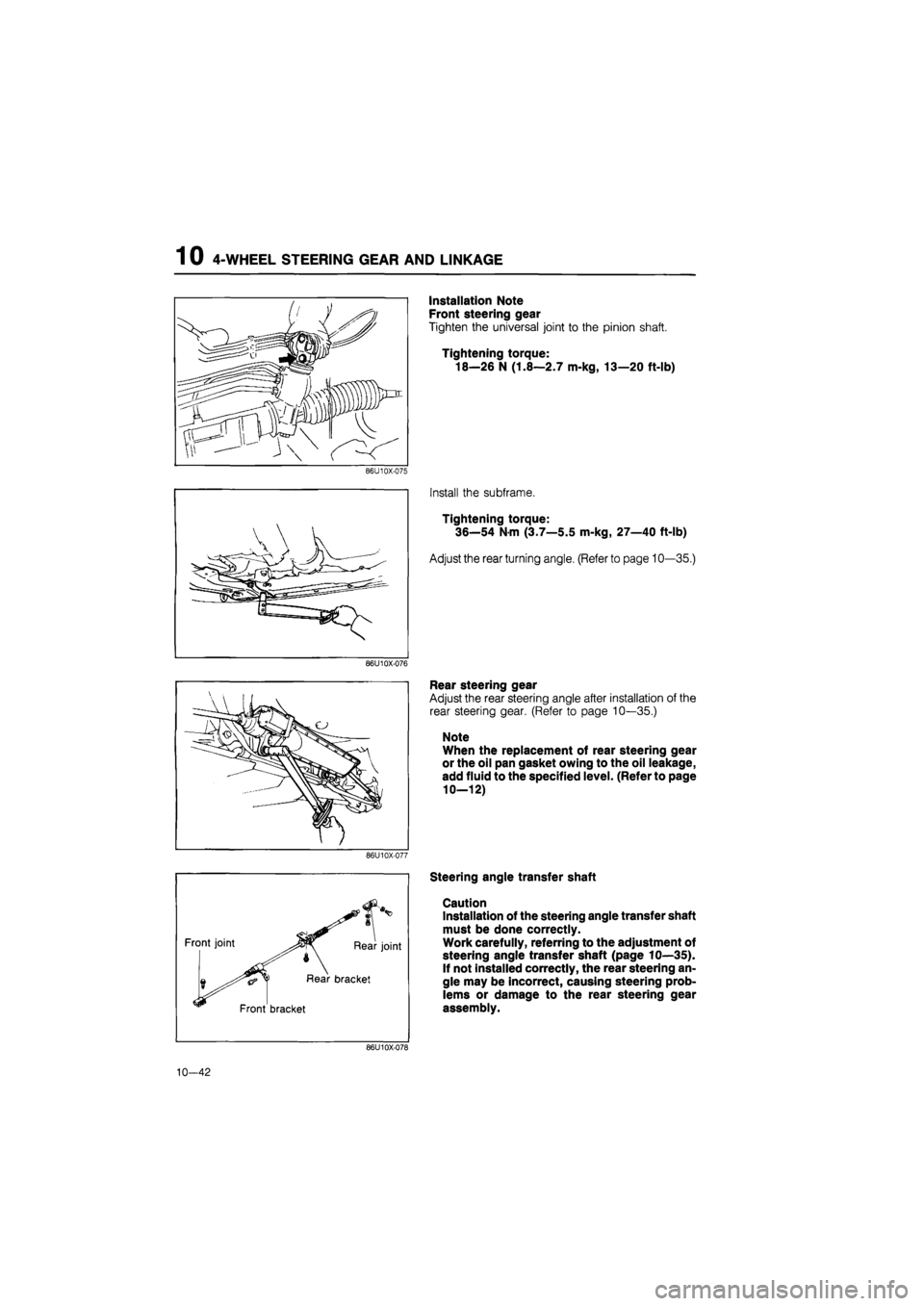
1 0 4-WHEEL STEERING GEAR AND LINKAGE
86U10X-075
86U10X-076
86U10X-077
Front joint Rear joint
Rear bracket
Front bracket
Installation Note
Front steering gear
Tighten the universal joint to the pinion shaft.
Tightening torque:
18—26 N (1.8—2.7 m-kg, 13—20 ft-lb)
Install the subframe.
Tightening torque:
36—54 Nm (3.7—5.5 m-kg, 27—40 ft-lb)
Adjust the rear turning angle. (Refer to page 10—35.)
Rear steering gear
Adjust the rear steering angle after installation of the
rear steering gear. (Refer to page 10—35.)
Note
When the replacement of rear steering gear
or the oil pan gasket owing to the oil leakage,
add fluid to the specified level. (Refer to page
10—12)
Steering angle transfer shaft
Caution
Installation of the steering angle transfer shaft
must be done correctly.
Work carefully, referring to the adjustment of
steering angle transfer shaft (page 10—35).
If not installed correctly, the rear steering an-
gle may be incorrect, causing steering prob-
lems or damage to the rear steering gear
assembly.
86U10X-078
10—42
Page 1547 of 1865
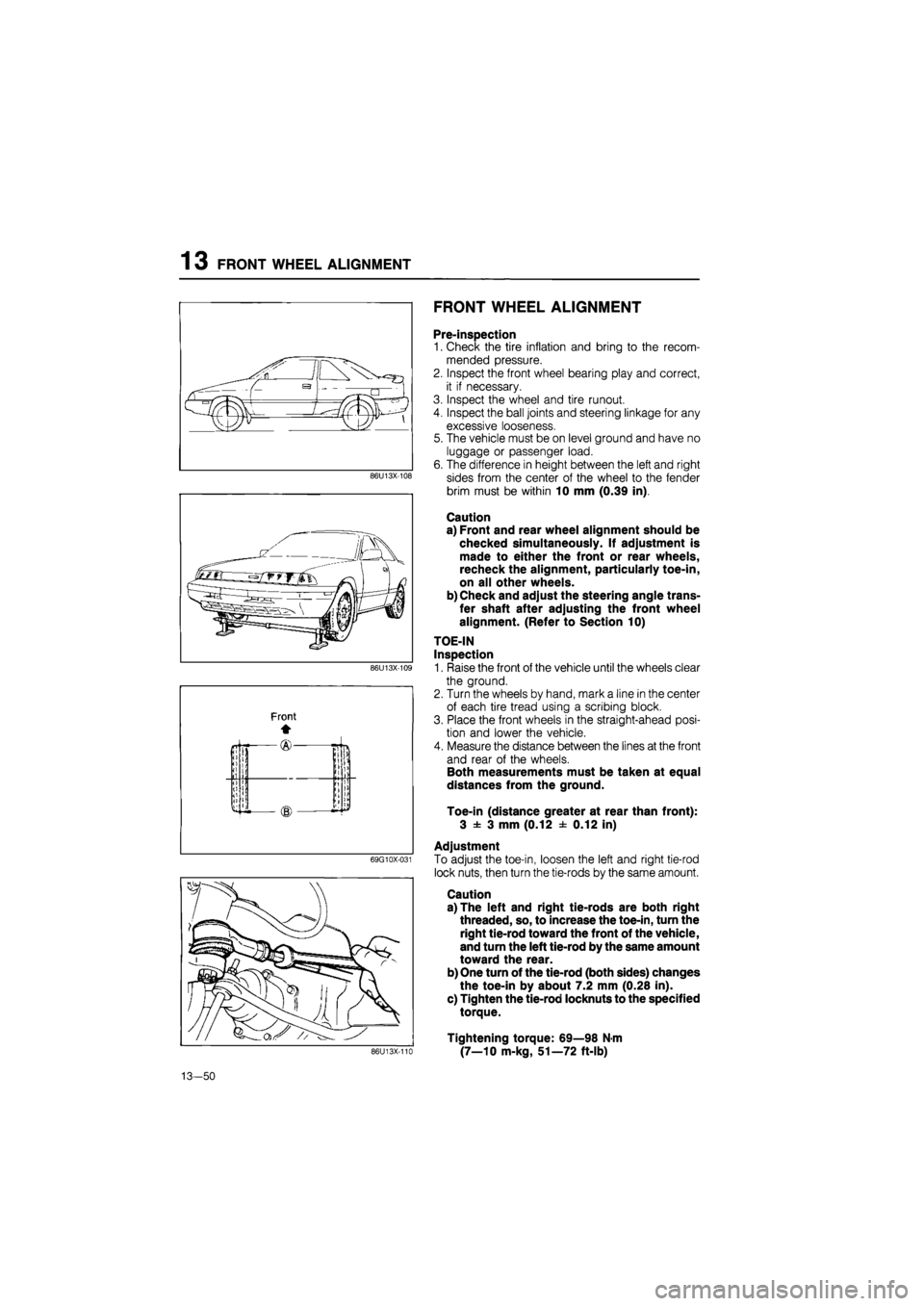
1 3 FRONT WHEEL ALIGNMENT
FRONT WHEEL ALIGNMENT
86U13X-108
69G10X-031
Pre-inspection
1. Check the tire inflation and bring to the recom-
mended pressure.
2. Inspect the front wheel bearing play and correct,
it if necessary.
3. Inspect the wheel and tire runout.
4. Inspect the ball joints and steering linkage for any
excessive looseness.
5. The vehicle must be on level ground and have no
luggage or passenger load.
6. The difference in height between the left and right
sides from the center of the wheel to the fender
brim must be within 10 mm (0.39 in).
Caution
a) Front and rear wheel alignment should be
checked simultaneously. If adjustment is
made to either the front or rear wheels,
recheck the alignment, particularly toe-in,
on all other wheels.
b) Check and adjust the steering angle trans-
fer shaft after adjusting the front wheel
alignment. (Refer to Section 10)
TOE-IN
Inspection
1. Raise the front of the vehicle until the wheels clear
the ground.
2. Turn the wheels by hand, mark a line in the center
of each tire tread using a scribing block.
3. Place the front wheels in the straight-ahead posi-
tion and lower the vehicle.
4. Measure the distance between the lines at the front
and rear of the wheels.
Both measurements must be taken at equal
distances from the ground.
Toe-in (distance greater at rear than front):
3 ± 3 mm (0.12 ± 0.12 in)
Adjustment
To adjust the toe-in, loosen the left and right tie-rod
lock nuts, then turn the tie-rods by the same amount.
Caution
a) The left and right tie-rods are both right
threaded, so, to increase the toe-in, turn the
right tie-rod toward the front of the vehicle,
and turn the left tie-rod by the same amount
toward the rear.
b) One turn of the tie-rod (both sides) changes
the toe-in by about 7.2 mm (0.28 in).
c) Tighten the tie-rod locknuts to the specified
torque.
Tightening torque: 69—98 N-m
(7—10 m-kg, 51—72 ft-lb) 86U13X-110
13-50
Page 1548 of 1865
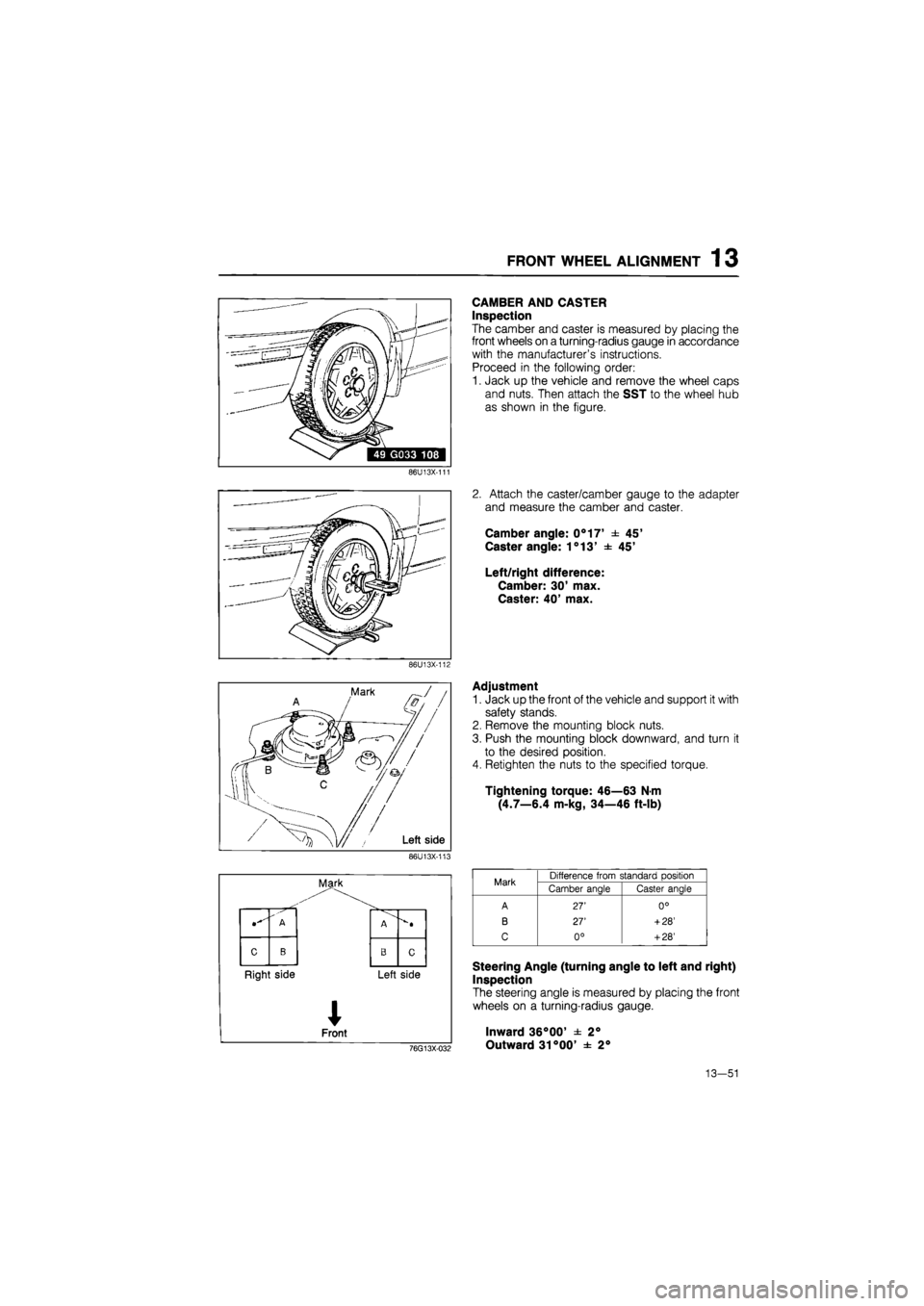
FRONT WHEEL ALIGNMENT 13
86U13X-111
86U13X-112
86U13X-113
Mark
" A
c B
Right side
Front
A
B c
Left side
CAMBER AND CASTER
Inspection
The camber and caster is measured by placing the
front wheels on a turning-radius gauge in accordance
with the manufacturer's instructions.
Proceed in the following order:
1. Jack up the vehicle and remove the wheel caps
and nuts. Then attach the SST to the wheel hub
as shown in the figure.
2. Attach the caster/camber gauge to the adapter
and measure the camber and caster.
Camber angle: 0°17' ± 45'
Caster angle: 1°13' ± 45'
Left/right difference:
Camber: 30' max.
Caster: 40' max.
Adjustment
1. Jack up the front of the vehicle and support it with
safety stands.
2. Remove the mounting block nuts.
3. Push the mounting block downward, and turn it
to the desired position.
4. Retighten the nuts to the specified torque.
Tightening torque: 46—63 N-m
(4.7—6.4 m-kg, 34—46 ft-lb)
Mark Difference from standard oosition Mark Camber angle Caster angle
A 27' 0°
B 27' + 28'
C 0° + 28'
76G13X-032
Steering Angle (turning angle to left and right)
Inspection
The steering angle is measured by placing the front
wheels on a turning-radius gauge.
Inward 36°00' ± 2°
Outward 31°00' ± 2°
13—51
Page 1549 of 1865
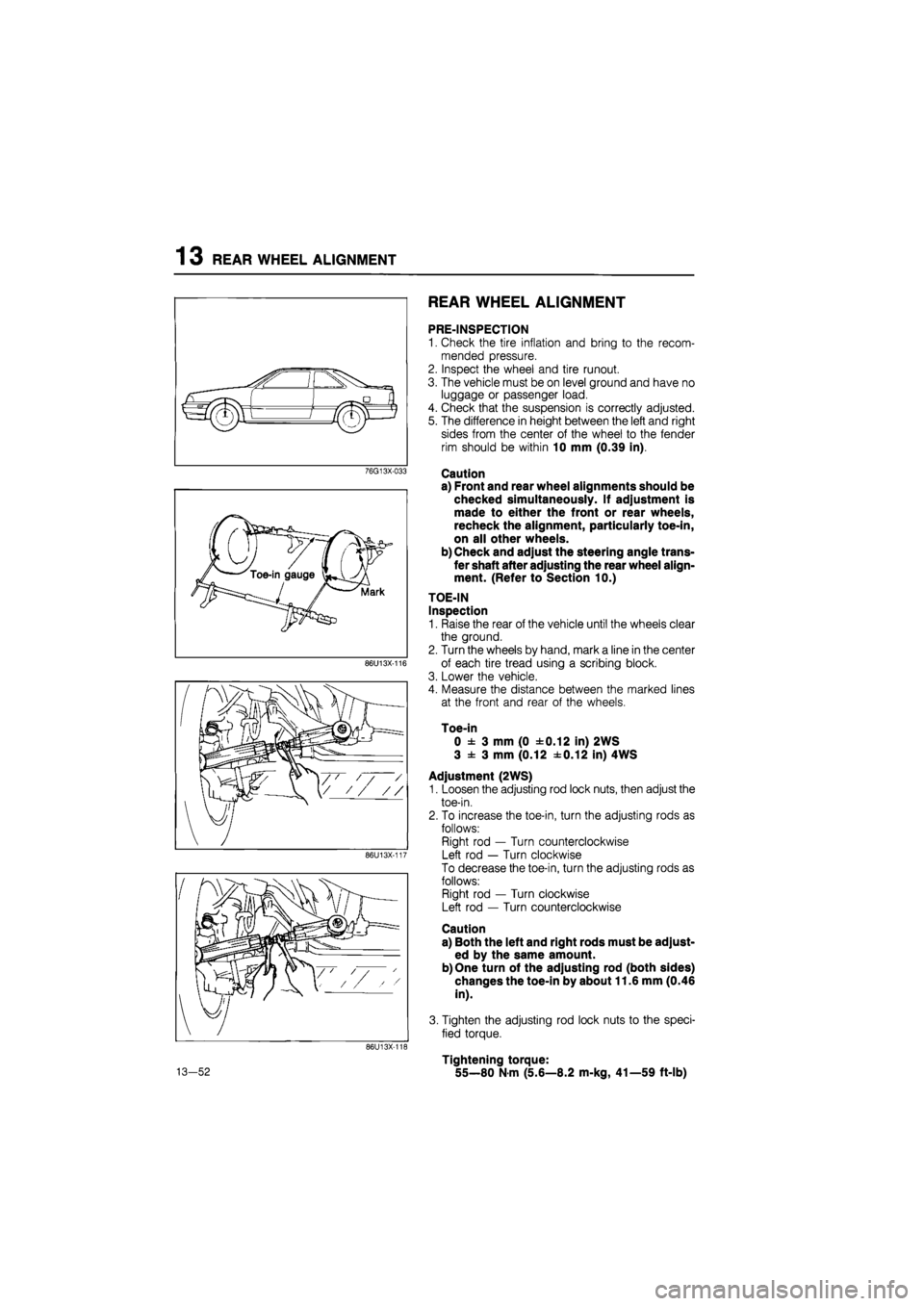
13 REAR WHEEL ALIGNMENT
76G13X-033
86U13X-116
86U13X-117
86U13X-116
13-52
REAR WHEEL ALIGNMENT
PRE-INSPECTION
1. Check the tire inflation and bring to the recom-
mended pressure.
2. Inspect the wheel and tire runout.
3. The vehicle must be on level ground and have no
luggage or passenger load.
4. Check that the suspension is correctly adjusted.
5. The difference in height between the left and right
sides from the center of the wheel to the fender
rim should be within 10 mm (0.39 in).
Caution
a) Front and rear wheel alignments should be
checked simultaneously. If adjustment is
made to either the front or rear wheels,
recheck the alignment, particularly toe-in,
on all other wheels.
b) Check and adjust the steering angle trans-
fer shaft after adjusting the rear wheel align-
ment. (Refer to Section 10.)
TOE-IN
Inspection
1. Raise the rear of the vehicle until the wheels clear
the ground.
2. Turn the wheels by hand, mark a line in the center
of each tire tread using a scribing block.
3. Lower the vehicle.
4. Measure the distance between the marked lines
at the front and rear of the wheels.
Toe-in
0 ± 3 mm (0 ±0.12 in) 2WS
3 ± 3 mm (0.12 ±0.12 in) 4WS
Adjustment (2WS)
1. Loosen the adjusting rod lock nuts, then adjust the
toe-in.
2. To increase the toe-in, turn the adjusting rods as
follows:
Right rod — Turn counterclockwise
Left rod — Turn clockwise
To decrease the toe-in, turn the adjusting rods as
follows:
Right rod — Turn clockwise
Left rod — Turn counterclockwise
Caution
a) Both the left and right rods must be adjust-
ed by the same amount.
b) One turn of the adjusting rod (both sides)
changes the toe-in by about 11.6 mm (0.46
in).
3. Tighten the adjusting rod lock nuts to the speci-
fied torque.
Tightening torque:
55—80 N-m (5.6—8.2 m-kg, 41—59 ft-lb)